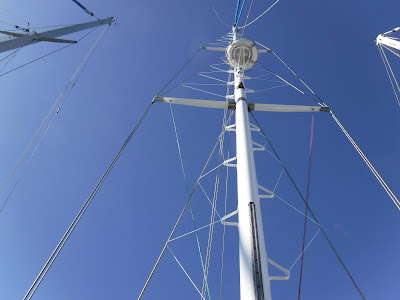During last year's Bunbury Cruise the Raymarine C120 chart plotter started the pattern of rebooting itself every 3 minutes or so. Despite the annoyance I was able to use it for my return to Fremantle.
During the winter I described the problem go Greg Hansen, a semi retired and extremely experienced marine electronics specialist. After an inspection he deemed the unit irreparable due to its age in this era of fast turnover of models and to responsibility to long-term support.
The cost of a replacement was from memory about $2500. It took me a few months to get over the sticker shock and bow to the inevitable so I contacted Greg to arrange a replacement. Fortunately toward the end of our discussion I casually asked if my radar would work with the new chart plotter. The answer was No because the new "Quantum" radar supersedes the old analogue technology. From memory a new radar would cost just over $2,000. My choice were (1) new chart plotter and radar at probably more than $5,000 if labor was included, (2) new chart plotter only and trash the current working radar at a cost of more than $2,500, (3) get creative and find another solution.
I purchased a appropriately sized computer monitor which I would mount in place of the chart plotter to project the screen of either one of my excellent laptop software packages. I got far into this plan before realizing that there would be problems in interfacing the output from the AIS transponder to the monitor, with a solution costing hundreds of dollars. This failed effort cost me only $20 for the monitor and a few hours of time at the computer and in the garage.
Then I got the bright idea of searching for a used C120. To my delight I found one on eBay out of the Sydney area for $650. I placed the order, paid, received confirmation, and a day later the order was cancelled by the vendor, who reported that when he went to the boat to fetch the unit he learned that the owner had sold it to somebody else.
So I looked again and found one out of the U.S.A. for about $450 USD. I ordered it knowing that I would take a hit from the currency exchange, shipment, and import duty of 10%. All up the unit cost me about $900 AUD. However, the unit was in excellent condition, was fully functional, and once again I had a chart plotter with radar.
I mentioned this to Greg as a courtesy and he replied that had he known he could get his hands on two used C120's for me. (Grrrr!) I replied that I would be very interested in the units as spares, but given that they were out of town I told him to take time to get them at his convenience because I was in no hurry.
The months passed and just before sending a query to Greg I had a look in eBay and found another C120 for sale out of Airlie Beach, Qld for $350. I snapped it up and it arrived a week later. The next day I mounted the unit and tested it to find that it could not see my radar, no matter what I tried. I contacted Greg who came to the conclusion that some sort of radar interface component in the C120 was faulty. OK, I asked, is it feasible to get a replacement radar interface from my original and faulty C120? Greg replied that it was worth a try. I then contacted the vendor, explained the problem, and told him that I was happy to keep the unit with no claim from him given the modest price of $350 and at the very worst I would wind up with a backup chart plotter which is much more important to me than the radar. I also noted that the cabling that had arrived with his unit did not include a radar cable, so who knows, the C120 had perhaps been originally supplied without a radar option.
 |
Raymarine C120 Chart Plotter Hospital
|
So the matter stands, and here is a photo of my C120 "hospital", the original faulty one at the left, the Airlie Beach one that cannot see the radar in the middle, and the fully functional USA one at the right.









